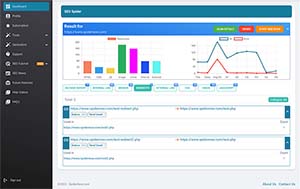Redirects for smooth user experience and SEO success
Effective management of website redirects for delivering user experience and maintaining SEO performance.

Optimizing Website Redirects for User Experience and SEO Success
A fundamental aspect of effective website management involves ensuring that users can navigate seamlessly to the right pages. This is where redirects come into play, serving as vital tools in the realm of web development. Redirects facilitate a smooth user experience while also safeguarding SEO rankings. In this essay, we will delve into the world of redirects, exploring their significance, types, auditing processes, and best practices to ensure the success of your website.Redirects, in essence, are HTTP responses that guide a web browser or a search engine crawler from one URL to another. They come into play when web pages are moved, deleted, or restructured, and the goal is to ensure that both users and search engines are effortlessly directed to the most relevant pages. Think of redirects as signposts on the vast internet highway, steering users and search engine bots toward their desired destinations.
Redirects come in various flavors, each designed to serve specific purposes. Permanent redirects, aptly named 301 redirects, indicate that a URL has been permanently moved to a new location. They are crucial for preserving SEO rankings and transferring the valuable link equity associated with the old URL. On the other hand, temporary redirects, known as 302 redirects, imply that the change is only temporary, and the original URL might be reinstated in the future. While 301 redirects are commonly used in SEO, 302 redirects have their niche applications.
Meta Refresh Redirects represent a different approach. These redirects are implemented using HTML meta tags and automatically send users to another page after a specified time delay. While they serve their purpose in specific scenarios, they are less SEO-friendly and not frequently used due to potential impacts on the user experience. JavaScript Redirects, operating on the client-side, are another variety. However, they are less SEO-friendly and typically not recommended for critical redirects due to their limitations. Lastly, Canonicalization, although not a traditional redirect, is essential in specifying the preferred version of a URL when there are multiple versions with similar content. It helps avoid issues related to duplicate content.
The significance of auditing redirects cannot be overstated. Properly configured and managed redirects are pivotal in maintaining a healthy website. Misconfigured or inadequately managed redirects can lead to a host of issues, including user frustration when encountering broken or poorly configured redirects. Such issues can drive users away from your site, ultimately affecting your website's performance and reputation.
Furthermore, mismanaged redirects can have a detrimental impact on your website's SEO rankings. Search engines may struggle to decipher changes in page structure, potentially leading to SEO penalties or the loss of valuable rankings. These inefficiencies can also affect the efficiency of search engine crawlers, which may spend excessive time crawling and re-crawling unnecessary redirects instead of indexing new content. Page load times can be negatively impacted by poorly implemented redirects, directly affecting user satisfaction and website performance. Therefore, auditing redirects is crucial to avoid these detrimental effects.
To effectively audit redirects, a systematic approach is required:
Compile a List of Redirects: The first step involves gathering a comprehensive list of all redirects on your website. This list should encompass both internal and external redirects. There are various tools and techniques available to generate this list, such as website crawling tools like SpiderNow or analyzing server logs.
Verify Redirect Types: With your list in hand, verify the types of redirects used. Ensure that permanent redirects (301s) are appropriately used for pages that have permanently moved, and temporary redirects (302s) are employed for temporary changes.
Check Redirect Chains and Loops: Thoroughly inspect your redirects for any chains or loops. Redirect chains occur when one URL redirects to another, which then redirects to a third URL. This can lead to slower page load times and negatively impact SEO. Redirect loops are even more problematic, creating an infinite cycle of redirects.
Review Redirect Targets: Examine the target URLs of your redirects. Ensure that they lead to the most relevant and up-to-date content. If you've undergone changes in your site structure or content organization, make sure the redirects accurately reflect these modifications.
Test for Broken Redirects: Rigorously test each redirect to ensure they function correctly. Broken redirects can lead to frustrating 404 errors for users and can harm your website's SEO. Utilizing automated tools can expedite the identification of broken redirects.
Analyze Redirect Performance: Consider the performance of your redirects, particularly their impact on page load times. Implementing redirects with minimal delay is essential for ensuring a positive user experience.
Monitor Redirect Logs: Set up monitoring and logging mechanisms for your redirects to track any new redirects that may emerge as you continue to update and modify your website over time.
In addition to the auditing process, adhering to best practices is vital to ensure your redirects effectively serve their intended purposes. These best practices include:
Using 301 Redirects for Permanent Changes: Whenever a page is permanently moved or deleted, employ 301 redirects to signal this change to search engines. This preserves your SEO rankings and transfers link equity.
Avoiding Redirect Chains and Loops: Maintain straightforward redirect structures and steer clear of chains or loops to sustain optimal website performance.
Regularly Updating Redirects: As your website evolves, make sure to update your redirects to reflect changes in content and site structure accurately.
Prioritizing User Experience: Minimize page load times by using efficient redirects. Always consider the impact on the user experience when implementing redirects.
Monitoring and Maintenance: Continuously monitor your redirects and make necessary adjustments to ensure they remain effective as your website grows and changes.
Redirects are indispensable tools in web development, facilitating user navigation and preserving SEO rankings during site changes. The proper auditing and management of redirects are critical to avoid user frustration, maintain SEO performance, and ensure a seamless user experience. By following best practices and conducting regular audits, you can harness the power of redirects to enhance your website's functionality and achieve success in the dynamic digital landscape.
The above information is a brief explanation of this technique. To learn more about how we can help your company improve its rankings in the SERPs, contact our team below.

Bryan Williamson
Web Developer & Digital Marketer

Web Developer & Digital Marketer
Digital Marketer and Web Developer focusing on Technical SEO and Website Audits. I spent the past 26 years of my life improving my skillset primarily in Organic SEO and enjoy coming up with new innovative ideas for the industry.













